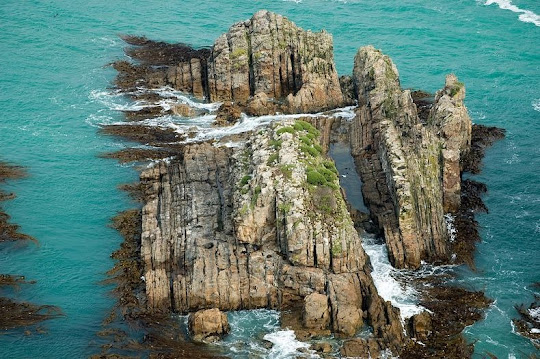Tucked deep within Chestnut Ridge Park, New York, is a small waterfall called the Eternal Flame Falls. The waterfall is so called because of a simple phenomenon – a natural gas leak just underneath the falls that just happens to be burning. The flame is not really "eternal" in the sense that it goes out occasionally. Often it is re-lit by the next hiker that finds it extinguished.
Chestnut Ridge Park is situated on 1213 acres of the northern face of a series of hills sandwiched between the Eighteenmile Creek and West Branch Cazenovia Creek valleys in Erie County. The park itself is a superb summer family destination containing miles of hiking trails, cycling paths, several playing fields, tennis courts, and a wealth of picnic facilities and shelters. Eternal Flame Falls, despite being located within the park boundaries, is off on the fringe, away from the crowds, and most directly accessible from a trail that begins on the southern edge of the park.

As you approach the falls, the smell of rotten-egg hits your nose. What you smell is the natural gas that leaks from between the shale layers. The gasses produced during the decomposition of the organics within the rock deposits are under pressure and push out through cracks and loose layers within the rock. One large fissure is located right within Eternal Flame Falls, in a small grotto that protects the gas seepage from the falling water and any wind, enabling it to sustain a flame when lit. Two other, smaller seepages within the grotto can be lit, although they can't hold a flame as large or as long as the primary flame. There are several other gas seepages, or springs, around the falls, but locating them can be tricky and lighting them often impossible. Some are located underneath the pool below the falls, and can be seen as bubbles rising up from the bedrock below.
Eternal Flame Falls is highly dependant on rainfall and melt water. It is usually only flowing in early spring, or after long bouts of heavy rain. It reaches 30 ft high, cascading over sloping shale in two segments. A small grotto, 5 ft up from the creek bed, to the right houses the natural gas spring that can be ignited to create a flame of 4-8 inches in height. When flow is high, the water pours over the grotto, covering the flame and diffusing the light like a lampshade.
Eternal Flame Falls is truly one of the most unique waterfalls in the country and one of the few remaining natural areas that we find on our planet. It is said that the falls may be the only one of its kind on the planet.


Source
READ MORE»
Chestnut Ridge Park is situated on 1213 acres of the northern face of a series of hills sandwiched between the Eighteenmile Creek and West Branch Cazenovia Creek valleys in Erie County. The park itself is a superb summer family destination containing miles of hiking trails, cycling paths, several playing fields, tennis courts, and a wealth of picnic facilities and shelters. Eternal Flame Falls, despite being located within the park boundaries, is off on the fringe, away from the crowds, and most directly accessible from a trail that begins on the southern edge of the park.

As you approach the falls, the smell of rotten-egg hits your nose. What you smell is the natural gas that leaks from between the shale layers. The gasses produced during the decomposition of the organics within the rock deposits are under pressure and push out through cracks and loose layers within the rock. One large fissure is located right within Eternal Flame Falls, in a small grotto that protects the gas seepage from the falling water and any wind, enabling it to sustain a flame when lit. Two other, smaller seepages within the grotto can be lit, although they can't hold a flame as large or as long as the primary flame. There are several other gas seepages, or springs, around the falls, but locating them can be tricky and lighting them often impossible. Some are located underneath the pool below the falls, and can be seen as bubbles rising up from the bedrock below.
Eternal Flame Falls is highly dependant on rainfall and melt water. It is usually only flowing in early spring, or after long bouts of heavy rain. It reaches 30 ft high, cascading over sloping shale in two segments. A small grotto, 5 ft up from the creek bed, to the right houses the natural gas spring that can be ignited to create a flame of 4-8 inches in height. When flow is high, the water pours over the grotto, covering the flame and diffusing the light like a lampshade.
Eternal Flame Falls is truly one of the most unique waterfalls in the country and one of the few remaining natural areas that we find on our planet. It is said that the falls may be the only one of its kind on the planet.


Source


























































